
Chen Danqing is the author of the most expensive work of Chinese contemporary art
ArtWizard 15.04.2024
Chen Danqing was born 1953 in Shanghai, but his parents were natives of Taishan County, Guangdong Province. His father Chen Zhaochi, who was very fond of Wen Tianxiang's poetry gave him his name, taking characters from the poet's line that mean pure heart and loyalty. Chen grew up on the bustling streets of Shanghai, and loved to draw from an early age. When he was 4 years old, his father was labelled a "right-wing element" because Chen Danqing's grandfather Chen Dizhong had studied at the Wampu Military Academy.
During the "Cultural Revolution" era, Chen Danqing started making portraits of Chairman Mao everywhere with his school art teacher. "I painted more than 100 portraits of Chairman Mao on the walls of the streets of Shanghai and its suburbs, as well as on the iron sheets of factories," he says. "At that time, there were millions of amateur and professional artists in China who painted millions of portraits of Mao Zedong." In 1970, Chen became a "cultural revolution" exile as part of a nationwide programme of forced collectivisation. In his 16th year, the young man found himself far from his loved ones, working in rural brigades in South Jiangxi, in North Jiangsu. In 1973, Chen Danqing transferred to a rural brigade in Jiangpu Shiqiao commune in northern Jiangsu province and continued to study painting on his own. His completed works during this period include Writing a Letter to Chairman Mao (a painting that expresses the desire of young people to stay in the countryside), Tears Flooding the Autumnal Fields, as well as a number of oil paintings and Lianhuanua works (a type of palm-sized picture book with sequential drawings popular in China in the 20th century) on the theme of the Chinese Civil War. Well known in the art community, his sketches were already being imitated by his peers.
In 1976, Chen was seconded to Tibet. It was his first trip to the mountainous region. Tibet had a decisive influence on Danqing. During the period of the "Cultural Revolution", he found a special theme, that of ethnic minorities, which laid the foundation for the subsequent cycle of Tibetan Paintings in 1980. Therefore, the first outstanding oil works Harvest Fields Flooded, The army entering Tibet, created in 1977, made it to the National Art Exhibition and All-Army Art Exhibition. At that time, these works had great influence in the country. Chen Danqing began to be called "the artist of educated youth" and the most outstanding of them.
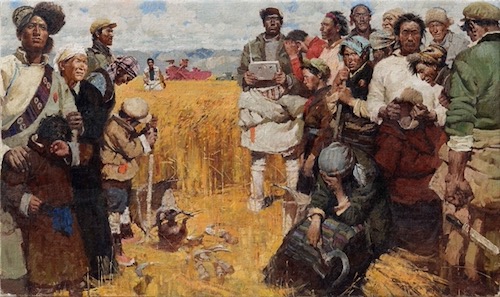
Chen Danqing, Harvest Fields Flooded, 1977
Courtesy Tang Contemporary Art
In 1978, he was admitted to the China Central Academy of Fine Arts' postgraduate programme of oil painting, which enabled him to obtain an artist's diploma. That year at the National Art Museum of China, the artist saw for the first time the works of French realist Jean-François Millet and inspired by them, Chen decided to paint in the same manner. "I was 20 years old at the time, and I was as arrogant as all the young oil painters trying to prove they could paint like foreigners," he says. Millet painted the simplest moments: peasants resting, women breastfeeding, people gathering and drying wheat, praying and sowing. "If you had seen revolutionary paintings from 50 years ago and paintings of farmers, you would understand why I was attracted to Millet’s work - why I was drawn to real moments and painted them," Chen says. "His simplicity and richness attracted me." It can be said that Chen combined the black-and-white depiction of the present-day women with Millet's famous painting Des glaneuses, 1957, to show the difference between the aspirations of modern middle-class women and the aspirations of nineteenth-century French rural women.
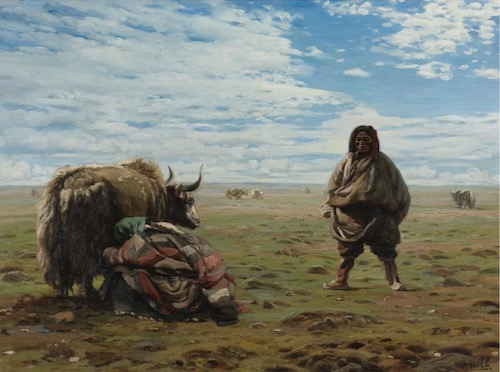
Chen Danqing, Nomads, 1982
Courtesy Tang Contemporary Art
In 1980, after graduation, Danqing was retained to teach oil painting in the academy's studio. It was then that he travelled to Tibet for the second time to prepare his graduation works on Painting of Tibetan Groups, creating seven paintings and many studies. These paintings are: Mothers and Children, Shepherds, Pilgrimage, Go to Town I, Go to Town II, Lady Washing Hair, Kamba Man. These later came to be called Tibetan paintings. In these paintings we see weather-affected people, dressed in traditional Tibetan attire, going about their daily lives in the field. fleeting moments, such as a stolen kiss or a Tibetan girl tending her yaks, are captured in sombre, earthy colours.
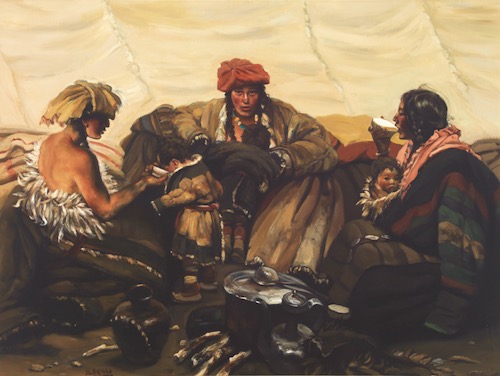
Chen Danqing, Mothers and Children, 1982
Courtesy Tang Contemporary Art

Chen Danqing, Tibetan Village, 1982
Courtesy Tang Contemporary Art
In his new works, the artist has moved away from the dimensions of his early social realist paintings in favour of the intimate style and scale of the nineteenth-century French naturalists. He depicted Tibetans in a dignified, direct manner, avoiding the patronising portrayal of ethnic minorities common at the time. Danqing's paintings of Tibet have become an event of the art world, both at home and abroad, and are considered classics of modern realist painting based on European traditions. The aim of this series of paintings was to emphasise the evolution from Soviet-influenced realism to classical European realism in Chinese oil painting, which now focuses on everyday life rather than heroes.
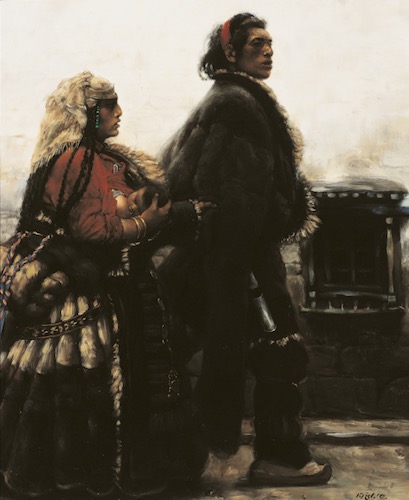
Chen Danqing, Go to Town II, 1981
Courtesy Tang Contemporary Art
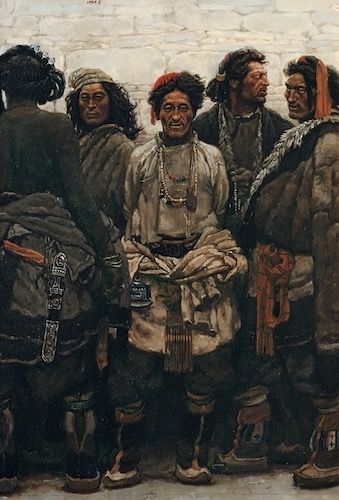
Chen Danqing, Kamba Man, 1980
Courtesy Tang Contemporary Art
When the top three most successful contemporary artists of the first half of 2021 were published, the ranking included those authors whose works in the period under review were sold for the highest sums. Predictable leader Jean-Michel Basquiat was joined by digital artist Beeple, as well as a relatively new to the Western art market Chinese artist Chen Danqing.
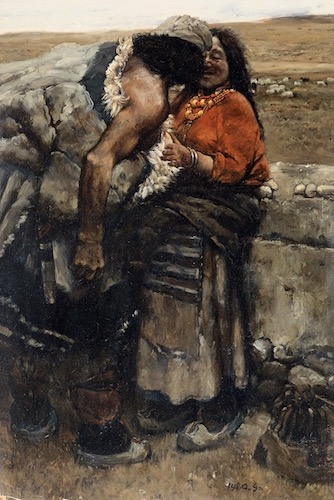
Chen Danqing, Shepherds, 1980
Courtesy Tang Contemporary Art
Quite unexpectedly the third contemporary artist on the pedestal of this period's price records, Chen Danqing added a staggering USD 21.7 million to his previous auction record at Poly International Beijing in early June, 2021. The work, Shepherds from the Tibet Series, stands less than 80cm tall and depicts a Tibetan couple about to kiss against the backdrop of the vast Lhasa prairie. The canvas from 1980, oil on cardboard, achieved nearly USD 25.2 million against the previous record of USD 3.5 million set a decade ago at the same auction. Danqing's painting, from a celebrated series of works depicting Tibetan scenes and people, became the most expensive piece of Chinese contemporary art ever sold at auction, surpassing the records of Zeng Fanzhi (USD 23.3 million) and Chen Yifei (USD 22.6 million) and propelling the artist into the global top 20 contemporary artists (in terms of annual turnover), ahead of Damien Hirst!
